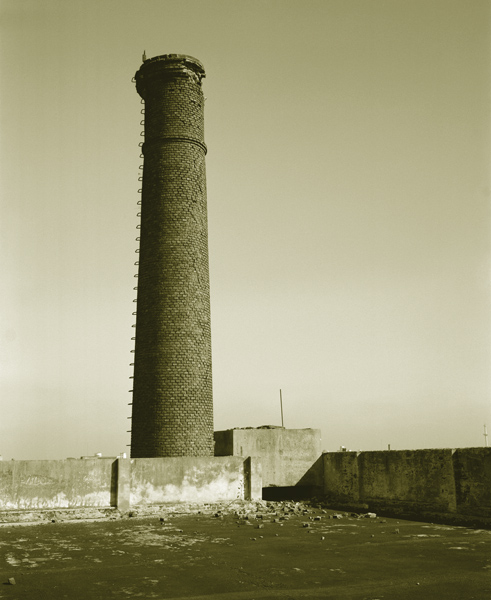[Fall 2009]
Occurrence, Espace d’Art, and d’Essai Contemporain, Montreal
May 14 to June 13, 2009
Sylvie Readman traveled to Argentina to create the core elements for her latest project, S’absenter (2009), exhibited recently at Espace Occurrence in Montreal. The refined and masterful seven photographs and three videos that form this project invite the viewer into a realm in which memory extends beyond the romantic terrain often associated with her creations. While the title suggests a void, this absence is filled with a tension in which the two media channel Readman’s expressionistic images of the past into insistent activators of memory.
The still images in S’absenter are Readman’s treatments of a ruined factory in Buenos Aires – a corpus of personal and historical signifiers. Individually, or in dialogue with the project’s videos, these images contain connotative temporal and spatial metaphors highlighting modernism’s tie to socioeconomic difference. As Paulette Gagnon has noted, Readman’s photographs often result from the use of manipulative strategies that force “the spectator’s gaze to confront the ambiguity of our relationship to reality.”1 However, S’absenter introduces a new component in Readman’s vocabulary: while her photographs and videos continue their role as links to a poetic “collective and autobiographical memory,”2 they also intervene as indigenous triggers in a social space in which private and public memories are tainted with human conflict.
The series, elegantly exhibited across the gallery’s two rooms, provokes a sense of push-and-pull in visitors, as the photographs and videos envelop them in an experience of antithetical signs linked to constantly interplaying reminders of private and collective past. Readman introduces her narrative with S’absenter video #1 – a video with sound – and a large photographic diptych, S’absenter photographie #2; the latter captures visitors’ gaze as they enter, while the audio track of the former elicits attention in the opposite direction. The two photographs of a tall, abandoned factory chimney are the same exposure of the imposing industrial smokestack, one printed as a negative, the other as a positive toned in a yellowish green. The images point to photography’s role in recording “a set of appearances from the otherwise inevitable supercession of further appearances,”3 while also acting as a paradoxical referent to a photograph from the artist’s autobiographical memory. Reflux ou les herbes fraîches (1995) is remembered here: a landscape photograph of a stern vertical plant stem figuring in the left part of the image set unbending in a stormy field, just as the smokestack in S’absenter stands in the left of the photos, but in ruin. Meanwhile, from the facing wall, the video projects a loop of images overwritten with personal text as the clanging sound of banging pots evokes the popular uprising associated with Argentina’s 2001 economic crisis, infusing the space with a tension linked to memories of social unrest. The video shows the textual side of an old postcard, empty except for the usual indications that include a photo credit, “Foto F. Bixio & Cia,” this absence provoking a juxtaposition in which personal and historic memory meet as the viewer probes his own mind for images of texts and photos to imagine on the postcard.
The photographs from this ruined post-industrial setting gradually build a feeling of unease that borders on the uncanny as the videos perform. They create an ambience, compensating for their small size through randomly spaced and layered audio emissions: the sound of a storm, a male opera voice, and the noise of metal on metal. All the while, out-of-focus multiple exposures of the factory seem to question the viewer’s memory about this landscape – an environment in which no human figure can be seen. Elsewhere in the gallery, a video shows the slow-paced passing from hand to hand of an old black-and-white photographic portrait.
The resonance of an ongoing exchange among romanticism, realism, and the pass- ing of time is a theme that permeates Readman’s oeuvre as well as her photo- graphs. Her compositions often result from manipulative technical interventions interjected at various stages of the photographic process. These creative intrusions – involving multiple exposures and combination printing, to name but a few – are historically linked to the mid-nineteenth century. Readman’s application of this methodology results in invisible layerings that become part of the photos and connote an idea of the artist as a creator of what Baudelaire termed the “way of feeling”4 that is a cornerstone of romantic thought. The richness of Readman’s creative vocabulary places her work well beyond any simple categorization. Nevertheless, her inclusion of salient motifs associated with the history of modern art – imagination, emotion, travel, and memory – invest her creations with a persistent romantic undertone, as her images continue to explore an inspired interest in what she has described as “the indissociability of illusion and the real.”5
Paul Ricoeur notes, “We must not forget that everything starts, not from the archive, but from testimony.”6 Readman’s latest work provides a personal testimony that deals with a new type of landscape for the artist, one that, through recurrent use of socio-economic signifiers, transports Read- man’s creative landscape into another mnemonic realm that is not simply predominantly romantic but also persistently social.
2 Martha Langford, Scissors, Paper, Stone – Expressions of Memory in Contemporary Photography (Montreal: McGill-Queen’s University Press, 2007), p. 157.
3 John Berger, About Looking (New York: Vintage, 1980), p.55.
4 Charles Baudelaire, “Salon de 1846,” Baudelaire Oeuvres Complètes, vol. 2 (Paris: Bibliothèque de la Pléiade, 1976), p. 420 (our translation).
5 Sylvie Readman, Sylvie Readman Don Quichotte et la Photographie (Montreal: Optica, 1987), artist’s statement (our translation). 6 Paul Ricoeur, Memory, History, Forgetting, translated by Kathleen Blamey and David Pellauer (Chicago: University of Chicago Press, 2004), p. 147.
Philippe Guillaume is a photographer and master’s student in Concordia University’s Special Individualized Program (SIP). He holds a BFA in art history from Concordia University.


